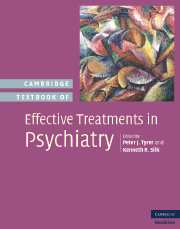Book contents
- Frontmatter
- Contents
- List of contributors
- Preface
- Part I Introduction
- 1 Classification of psychiatric disorders and their principal treatments
- 2 The history of psychiatric therapies
- Part II Summary of treatment modalities in psychiatric disorders
- Part III Specific treatments
- Appendix I Summary of specific drugs having evidence of effectiveness in mental disorders
- Appendix II Key to effectiveness tables
- Index
- References
2 - The history of psychiatric therapies
from Part I - Introduction
Published online by Cambridge University Press: 12 May 2010
- Frontmatter
- Contents
- List of contributors
- Preface
- Part I Introduction
- 1 Classification of psychiatric disorders and their principal treatments
- 2 The history of psychiatric therapies
- Part II Summary of treatment modalities in psychiatric disorders
- Part III Specific treatments
- Appendix I Summary of specific drugs having evidence of effectiveness in mental disorders
- Appendix II Key to effectiveness tables
- Index
- References
Summary
Editor's note
Those who do not understand history are destined to repeat it, so Professor Berrios' reminder of the history of therapeutics is opportune. We often like to think of therapeutic discoveries being made in a logical sequence but so many of them are random. The famous Cambridge experimental psychologist, Frederick Bartlett, described a large part of our memory processes as ‘effort after meaning’, and this is illustrated excellently in this account. We are reminded that the meanings of words and our understanding of therapies almost has to be retranslated every hundred years. It is also chastening to find out how many of our treatments are discovered entirely by chance and on misplaced premises (read the section on ECT and psychosurgery and then look at Chapter 4II for the more recent arguments) and how long it took for ineffective treatments such as insulin coma therapy to be discredited. Readers of Orwell's Animal Farm will be interested to note that Cerletti and Bini's work on the introduction of ECT originated in observations with pigs, which is a logical sequence of sorts. The other illuminating aspect of this chapter is the way we have been almost seduced into the idea that all maladies have a cure, and that ‘treatment resistance’ formalizes the notion that out there is a successful treatment for every illness, and it just needs a clever therapist to find it.
- Type
- Chapter
- Information
- Cambridge Textbook of Effective Treatments in Psychiatry , pp. 16 - 44Publisher: Cambridge University PressPrint publication year: 2008
References
- 3
- Cited by



